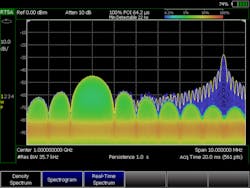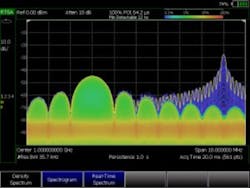Autotestcon products span power sources to portable analyzers
Anaheim, CA. New products were the theme for the second day of Autotestcon, beginning with AMETEK’s introduction of the Asterion AC power source, a California Instruments brand product. The first models in the range deliver 500 VA (AST501), 750 VA (AST751), and 1,500 VA (AST1501). Multiple units can be combined for higher power and/or multi-phase operation. Although described as AC power sources, the instruments also support DC output. Both AC and DC outputs have two ranges: 0 to 200 VAC or 0 to 400 VAC, and 0 to 250 VDC or 0 to 500 VDC. All units feature the company’s iX2 current doubling technology, which enables the output current to increase linearly up to 2x the full voltage current as the voltage decreases to half of the maximum.
AMETEK, through acquisition of VTI Instruments, also highlighted the SentinelEX series of PXIe switches that feature comprehensive signal-path shielding, isolation, and built-in health monitoring. Products include multiplexers, matrices, and discrete switches. Specific models are grouped as multipurpose, RF, or microwave.
National Instruments (NI) and Astronics Test Systems have collaborated on the design, manufacture, and marketing of a set of three more PXI instruments that can replace several VXI functions in new test systems. The modules are the Astronics PXIe-6943 Digital Test Instrument, the PXIe-3352 Rubidium Clock Source, and the PXIe-1209 Pulse Pattern Generator. These three products join the previously announced Astronics PXIe-2461 Frequency Time Interval Counter, introduced at last year’s Autotestcon. Software-defined instrument technology allows these modules to directly replace similar VXI functions, supporting unchanged TPS use.
Separately, NI has enhanced its TestStand test executive software application to provide simultaneous execution and development of multiple independent applications through TestStand Environments. The company also was exhibiting its recently launched 2-slot vector signal transceiver.
Keysight Technologies is expanding the services it offers from the familiar repair and calibration operations to include test asset management. Keeping track of calibration dates, suggested upgrades, newly available options, and obsolescence can be a big enough job that it detracts from a company’s basic objectives. Keysight can offload that work.
The company also demonstrated the latest improvements to the FieldFox line of fully portable signal analysis instruments. The real-time spectrum analyzer (RTSA) option adds the capability to deal with rapidly changing signals. In addition to the classic persisted RTSA spectrum display, a spectrogram mode also is available with color-graded power.
Electronic warfare was represented by software that supported configuring up to four signal generators to simulate multiple threats and their angles of attack. Also on the software side, a reference solution for the company’s PXIe-based radio test system is available. In addition to facilitating control of the test set’s separate instruments, the reference solution also allows test definition, which configures a number of instruments to accomplish a specific type of test.
Zurich Instruments makes compact instruments for the scientific market, although the company’s arbitrary waveform generators with synchronized ADCs have broader application. By ensuring simultaneous operation of the ARB and ADC, establishing cause/effect and latency measurements are supported.
Carmel Instruments was displaying the company’s line of time interval analyzers (TIA), which was acquired from Brilliant Instruments. A completely new design is promised soon.
RADX had the latest member of the LibertyGT series of configurable instruments on its stand—the model 1111B-MCRT2: multi-channel, real-time, radio test instrument. This line of software-defined synthetic instruments provides real-time spectrum analysis. It can be configured as a channelized real-time VSA with up to 128 receive channels with a variety of modulations. Or, it also can function as a 16 channel VSG, also with per-channel choice of modulation type.
Although not new at this show, the universal switching system on the Astronics stand (acquired via acquisition of the Ascor products part of Giga-tronics) drew lots of attention. In addition to providing high bandwidth, the system can connect any input pin to any other pin. Vertical signal cards plug in from the front and engage horizontal interconnection cards that plug in from the rear. According to Jeff Lum, the system’s designer and long-time Ascor technical lead, connecting pins on adjacent signal cards supports 1.5-GHz bandwidth. Routing a signal from one side of the system to the other reduces the bandwidth to about 600 MHz.
Papers attended
Between product demonstrations, I had the opportunity to attend several papers. Robert Waldeck, director of sales for special products at Astronics test Systems described the benefits of universal switching. This was the first presentation in the 8 AM session on Virtual Instrumentation and Switching, chaired by Teresa Lopes, Teradyne.
Because switches too often are an after-thought, from 10’ to 30’ of cable can be required to configure and connect switching to instruments and the EUT. Typically, there is a lot of wiring in the interface test adapter (ITA), and each connection has to be developed by tracing all the connections that are needed to accomplish a certain test. With the universal switching system, an ITA can be much simpler. Instead of the ITA having to accommodate a fixed set of signal connections, the switching system can be programmed to make the required signals appear where convenient in the ITA. Through path level switching, you can specify the end points that need to be connected and the universal system does the rest. Because switching effects are deterministic in this system, the ITA can contain built-in standards so that the complete switched path can be calibrated. Several signal cards have been developed according to voltage, current and frequency.
Dr. Christopher Heagney, Naval Air Station Jacksonville, FL presented the results of his research into fast support for electronic warfare signal analysis. Specifically, he was measuring jamming response time. When a jammer attacks, it switches frequency rapidly enough that the affected equipment doesn’t have time to analyze the jamming signal and form an appropriate response. Effectively, jamming only works during the time before the victim can respond to it—before the victim can jam the jammer.
Dr. Heagney built a test system that featured a 3.6-GS/s ADC and a 4.5-Gb/s DAC. By replacing the usual system computer with a fast FPGA, Heagney found that the latency from receiving a jamming signal to sending out a countering signal was about 92 ns—at least 20x faster than a PC. He worked with an ALQ-160 CW jammer and set up a test that switched between 84 and 196 MHz. He reasoned that because jamming uses digital RF memory to achieve high speed, associated ATE needed to be just as fast—it wasn’t.
The third paper in the session was presented by Troy Troshynski, Avionics Interface Technologies, part of Teradyne. Testing HS Ethernet and Fibre Channel Switches would seem straightforward given the high usage of both formats—but not so for avionics systems because of the special features of avionics protocols.
Test equipment must act as a slave to the switch under test. The system has to simulate a lot of data—the specific meaning isn’t important, but testing the maximum number of signals is. Because a high number of Ethernet ports are required, it’s desirable to generate the data on-board the test instrument together with timestamping to determine latency.
Avionics networks differ from the SAN applications that use Fibre Channel. Avionics networks tend to have tens of nodes, not hundreds or thousands, configurations are static, and rather than switching in milliseconds or tens of microseconds is needed. MIL STD 1760E, also called HS1760, uses 78-Ω cables and defines the interface between weapons and avionics systems. Basically, it maps the much slower 1553 protocol to 1-Gb/s fibre channel—defined as FC-AE-1553. This has a range of 30 m and messages can be up to 128 MB. Although the fibre channel specification allows several configurations, the avionics 1760E spec constrains the network topology to be a switch tree.
The main factors stressed were the need to use FPGA-based instruments because they can be reconfigured to suit custom avionics protocols and they can help generate patterns on board.
In a session later in the afternoon, chaired by Jesse Zapata, U.S. Navy, Herman van Eijkelenburg (Pacific Power Source) discussed the benefits and tradeoffs associated with switched mode AC power sources. Higher energy efficiency and much higher power density are two factors that allow the company’s new AFX series products to achieve 15 kW in a 4U height. Models up to 60 kVA are available.
About the Author


